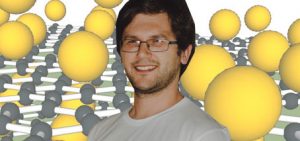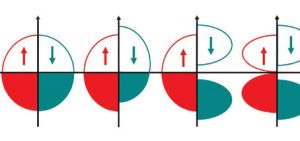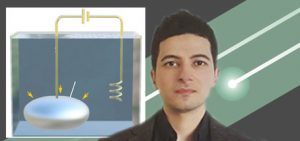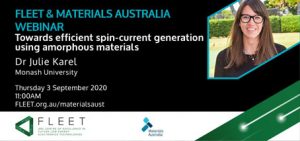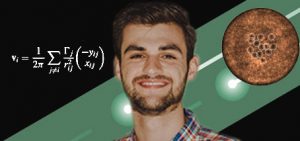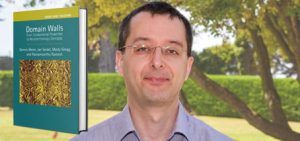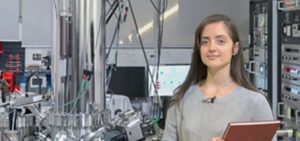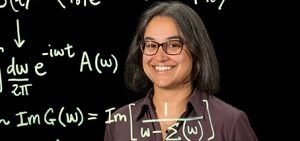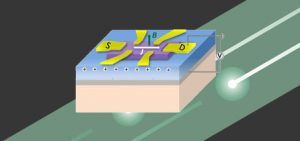FLEET News
FLEET physicists from Monash University and the University of Queensland are finalists, named today, in the Australian Museum Eureka Prizes – the nation’s top science awards. The Australian Quantum Vortex team provided the first proof of a 70-year-old theory of turbulence. Turbulence is everywhere, but remains one of physics’ great unsolved problems. Turbulence in two-dimensional flow, and the giant vortices …
What causes quasiparticle death? In large systems of interacting particles in quantum mechanics, an intriguing phenomenon often emerges: groups of particles begin to behave like single particles. Physicists refer to such groups of particles as quasiparticles. Understanding the properties of quasiparticles may be key to comprehending, and eventually controlling, technologically important quantum effects like superconductivity and superfluidity. Unfortunately, quasiparticles are …
Adding calcium to graphene creates an extremely-promising superconductor, but where does the calcium go? Adding calcium to a composite graphene-substrate structure creates a high transition-temperature (Tc) superconductor. In a new study, an Australian-led team has for the first time confirmed what actually happens to those calcium atoms: surprising everyone, the calcium goes underneath both the upper graphene sheet and a …
Quantum anomalous Hall effect (QAHE)-materials reviewed Magnetic topological insulators and spin-gapless semiconductors A collaboration across three FLEET nodes has reviewed the fundamental theories underpinning the quantum anomalous Hall effect (QAHE). QAHE is one of the most fascinating and important recent discoveries in condensed-matter physics. It is key to the function of emerging ‘quantum’ materials, which offer potential for ultra-low energy …
Imagine an alien world with oceans of liquid metal. If such a world exists, metallic elements are likely the sources of the dissolved materials and particles in these oceans. Everything would be made of metallic elements, even lifeforms. It may sound like a concept pulled straight out of a science fiction movie, but some basic elements of this fantastical vision …
Quantum materials are exploding in condensed-matter, cold-atom physics, materials science. #explainer The new IOP quantum materials roadmap explores current research, future challenges, technical applications, underlying physics in topological insulators, multiferroics, twisted-‘magic angle’ moiré graphene, superconductors (copper-based and TMD-based), topological semimetals, Majorana states + non-equilibrium phenomena (phew!) Read the roadmap ‘Emergent’ phenomena are key to FLEET’s search for ultra-low energy electronics …
An online audience of almost 90 tuned in this week to hear FLEET CI Dr Julie Karel describing her search for non-volatile memory technologies and associated materials challenges. The talk was co-hosted by FLEET and Materials Australia. Catch up on the talk here Julie described her own work at Monash Department of Material Science and Engineering developing materials that can …
An Australian-led study has provided new insight into the behaviour of rotating superfluids. A defining feature of superfluids is that they exhibit quantised vortices – they can only rotate with one, or two, or another integer amount of rotation. Despite this key difference from classical fluids, where vortices can spin with any strength, many features of the collective dynamics of …
FLEET CI Prof Jan Seidel (UNSW) is co-editor on a new book titled “Domain Walls – From Fundamental Properties to Nanotechnology Concepts” published by Oxford University Press. It is the first to cover the emerging field of ferroelectric domain walls in depth, from underlying nanoscale material properties to prototype and emerging nanoelectronics technology and future research concepts in the area. …
—Written by Dr Iolanda di Bernardo, FLEET/Monash An Australian-led study uses a scanning-tunnelling microscope ‘trick’ to map electronic structure in Na3Bi, seeking an answer to that material’s extremely high electron mobility. In studying the topological Dirac semimetal, the team found that exchange and correlation effects are crucial to electron speed, and therefore mobility, and thus to the use of this …
Coronavirus lockdowns have led to a massive reduction in global emissions, but there’s one area where energy usage is up – way up – during the pandemic: internet traffic. Data-intensive video streaming, gaming and livestreaming for business, university and school classes, is chewing up energy. Read more: Netflix has capitalized on social isolation, but will its success continue in a post-coronavirus world? Estimates can be notoriously difficult and depend on the electricity …
Mobile phones and other electronic devices made from an organic material that is thin, bendable and more powerful are now a step closer thanks to new research led by scientists at The Australian University (ANU). Lead researchers Dr Ankur Sharma and Associate Professor Larry Lu say it would help create the next generation of ultra-fast electronic chips, which promise to be much faster than current electronic chips we use. “Conventional devices run …
Congratulations to FLEET CI A/Prof Meera Parish who received an ARC Future Fellowship in this week’s announcement. “The revolution in electronics and the Information Age were enabled by powerful theories based on the concept of the quasiparticle, an object composed of many particles such as electrons,” writes A/Prof Parish. The new ARC Fellowship will support Meera’s work to unravel the …
Interlayer coupling in vdW material Fe3GeTe2 successfully increased by insertion of protons A Chinese-Australian collaboration has demonstrated for the first time that interlayer coupling in a van der Waals (vdW) material can be largely modulated by a protonic gate, which inject protons to devices from an ionic solid. The discovery opens the way to exciting new uses of vdW materials, …
As COVID bites into academic budgets, it is getting even harder for PhD students to secure funding. Research indicates COVID is disproportionately hurting women in science, who are already under-represented in STEM, particularly in physics. In response, FLEET has introduced a new, third scholarship option for outstanding candidates who identify as women: New PhD partial-stipend scholarship: Maximum $15,000/year partial stipend …



